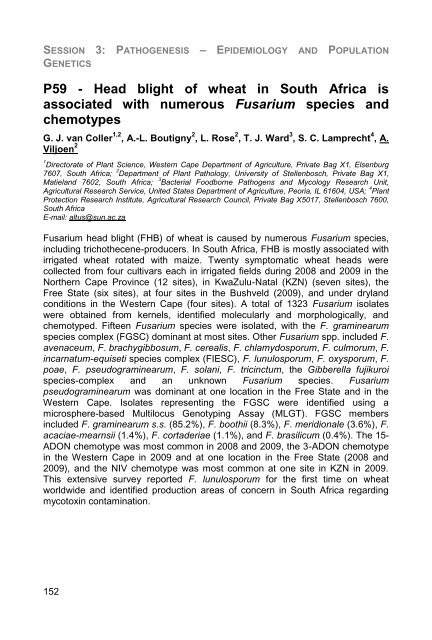EFS12- Book of abstracts - Contact
EFS12- Book of abstracts - Contact
EFS12- Book of abstracts - Contact
Create successful ePaper yourself
Turn your PDF publications into a flip-book with our unique Google optimized e-Paper software.
SESSION 3: PATHOGENESIS – EPIDEMIOLOGY AND POPULATION<br />
GENETICS<br />
P59 - Head blight <strong>of</strong> wheat in South Africa is<br />
associated with numerous Fusarium species and<br />
chemotypes<br />
G. J. van Coller 1,2 , A.-L. Boutigny 2 , L. Rose 2 , T. J. Ward 3 , S. C. Lamprecht 4 , A.<br />
Viljoen 2<br />
1 Directorate <strong>of</strong> Plant Science, Western Cape Department <strong>of</strong> Agriculture, Private Bag X1, Elsenburg<br />
7607, South Africa; 2 Department <strong>of</strong> Plant Pathology, University <strong>of</strong> Stellenbosch, Private Bag X1,<br />
Matieland 7602, South Africa; 3 Bacterial Foodborne Pathogens and Mycology Research Unit,<br />
Agricultural Research Service, United States Department <strong>of</strong> Agriculture, Peoria, IL 61604, USA; 4 Plant<br />
Protection Research Institute, Agricultural Research Council, Private Bag X5017, Stellenbosch 7600,<br />
South Africa<br />
E-mail: altus@sun.ac.za<br />
Fusarium head blight (FHB) <strong>of</strong> wheat is caused by numerous Fusarium species,<br />
including trichothecene-producers. In South Africa, FHB is mostly associated with<br />
irrigated wheat rotated with maize. Twenty symptomatic wheat heads were<br />
collected from four cultivars each in irrigated fields during 2008 and 2009 in the<br />
Northern Cape Province (12 sites), in KwaZulu-Natal (KZN) (seven sites), the<br />
Free State (six sites), at four sites in the Bushveld (2009), and under dryland<br />
conditions in the Western Cape (four sites). A total <strong>of</strong> 1323 Fusarium isolates<br />
were obtained from kernels, identified molecularly and morphologically, and<br />
chemotyped. Fifteen Fusarium species were isolated, with the F. graminearum<br />
species complex (FGSC) dominant at most sites. Other Fusarium spp. included F.<br />
avenaceum, F. brachygibbosum, F. cerealis, F. chlamydosporum, F. culmorum, F.<br />
incarnatum-equiseti species complex (FIESC), F. lunulosporum, F. oxysporum, F.<br />
poae, F. pseudograminearum, F. solani, F. tricinctum, the Gibberella fujikuroi<br />
species-complex and an unknown Fusarium species. Fusarium<br />
pseudograminearum was dominant at one location in the Free State and in the<br />
Western Cape. Isolates representing the FGSC were identified using a<br />
microsphere-based Multilocus Genotyping Assay (MLGT). FGSC members<br />
included F. graminearum s.s. (85.2%), F. boothii (8.3%), F. meridionale (3.6%), F.<br />
acaciae-mearnsii (1.4%), F. cortaderiae (1.1%), and F. brasilicum (0.4%). The 15-<br />
ADON chemotype was most common in 2008 and 2009, the 3-ADON chemotype<br />
in the Western Cape in 2009 and at one location in the Free State (2008 and<br />
2009), and the NIV chemotype was most common at one site in KZN in 2009.<br />
This extensive survey reported F. lunulosporum for the first time on wheat<br />
worldwide and identified production areas <strong>of</strong> concern in South Africa regarding<br />
mycotoxin contamination.<br />
152
















![Présentation CRB-anim [Mode de compatibilité] - Inra](https://img.yumpu.com/17418636/1/190x135/presentation-crb-anim-mode-de-compatibilite-inra.jpg?quality=85)